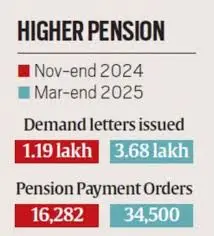EPFO head office flags ‘exceptionally high’ rejection of higher pension applications

A New Opportunity After Court Verdict
In November 2022, the Supreme Court upheld changes to the EPS made in 2014. Consequently, EPFO allowed eligible employees to contribute 8.33% of their actual salary—beyond the previous ₹15,000 per month wage ceiling—to claim higher pensions.
As a result, lakhs of employees across India rushed to apply for the revised pension scheme, expecting significantly better retirement benefits. Nevertheless, the journey since then has been far from smooth.
Current Status: Application Rejections Raise Red Flags
So far, EPFO has received 17.49 lakh applications. However, it has rejected around 7.35 lakh, leading to a 42% rejection rate—a figure the head office described as “exceptionally high.” Additionally, 3.92 lakh applications were returned to employers for corrections, and 2.24 lakh are still awaiting employer action. Shockingly, EPFO has finalized less than 1% of the total applications.
Clearly, the high rate of incomplete or stalled applications has hindered the rollout of the scheme.
Why Are So Many Applications Being Rejected?
Several factors have contributed to this unusually high rejection rate. Let’s examine the key reasons:
- Incomplete or Incorrect Submissions
Many applicants submitted forms with missing or inaccurate data, especially related to salary history and service records. As a result, EPFO could not process them. - Delayed Employer Action
In over 2 lakh cases, employers failed to verify and forward employee applications. Since EPFO requires joint verification, these delays stalled progress. - Requests for Additional Contributions
EPFO sent demand notices to approximately 2.19 lakh applicants, asking them to deposit additional amounts. Without timely responses, these applications remained unresolved. - Technical Glitches on the Portal
Several applicants faced login failures, data mismatches, and errors while uploading documents. These digital issues further delayed or disrupted submissions. - Lack of Standard Guidelines
Due to the absence of clear instructions from the head office, regional EPFO staff interpreted rules differently. This inconsistency led to confusion and irregular decision-making.
Financial Impact: A Looming Challenge
The large number of applications, if approved, would significantly strain EPFO’s financial resources. According to internal estimates:
- Approving even half of the applications may require an additional ₹1.86 lakh crore in pension funding.
- A review of 38,000 applications revealed a ₹9,500 crore deficit in the pension pool.
Clearly, these numbers indicate that the higher pension scheme, while beneficial to workers, could pose a long-term sustainability challenge.
Government and EPFO’s Response
In response to the growing concerns, Union Labour Minister Bhupender Yadav assured applicants that the government is working to resolve these issues. He acknowledged complaints related to portal errors and long processing times.
Moreover, the Central Board of Trustees (CBT) has emphasized the need to increase staff, enhance technical systems, and issue clearer guidelines to regional offices.
To accelerate the process, EPFO has:
- Set new deadlines for field offices to complete application reviews.
- Started weekly reviews to ensure accountability.
- Issued instructions to resolve incomplete and pending cases more efficiently.
What Can Applicants Do Now?
While EPFO works to improve the system, applicants must also take proactive steps:
- Double-check the accuracy of submitted details.
- Ensure that employers verify and forward their applications promptly.
- Respond immediately to any additional payment requests.
- Track application status through the EPFO portal.
For unresolved issues, members can file complaints using the EPFO Grievance Portal or CPGRAMS (Central Public Grievance Redress and Monitoring System).
Conclusion: Fixing the System for Fairer Pensions
In summary, EPFO’s higher pension scheme holds great promise, but poor execution has undermined public confidence. A lack of coordination, unclear guidelines, and technical barriers have blocked eligible members from accessing their rightful benefits.
Going forward, both EPFO and employers must streamline procedures, improve communication, and ensure transparency. Only then can lakhs of workers enjoy the retirement security they were promised.






